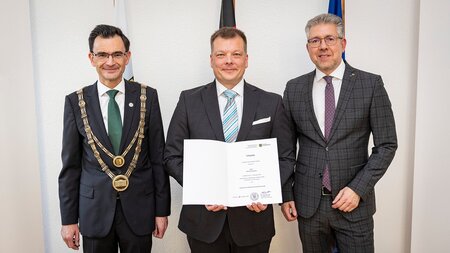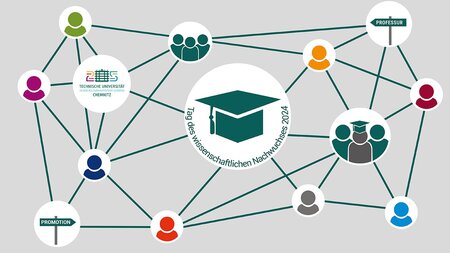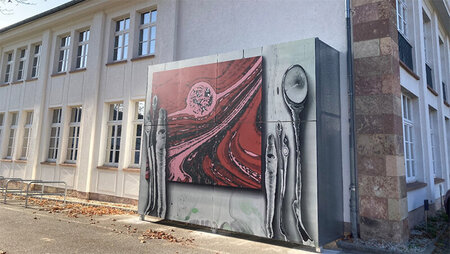Sustainable Living Technology
In a recent article in the high-profile journal “Advanced Materials”, researchers in Chemnitz show just how close and necessary the transition to sustainable living technology is, based on the morphogenesis of self-assembling microelectronic modules, strengthening the recent membership of Chemnitz University of Technology with the European Centre for Living Technology (ECLT) in Venice.
-

A self-folding microelectronic module (SMARTLET) on a surface that can integrate a wealth of functions, e.g. power supply, actuators, sensors and communication capabilities. The SMARTLET itself is made of soft materials and integrates a tiny Si chip in its shell that can store, process, receive and send data. A large number of cube-shaped SMARTLETs can be fabricated on a wafer surface with high throughput. The SMARTLET itself resembles a biological cell in its functionality and size. Graphic: Research Center MAIN -

Folding a planar microelectronic structure into a SMARTLET, which has the shape of a truncated octahedron. Graphic: Research Center MAIN -

Both cube-like SMARTLETs and SMARTLETs with a truncated octahedron shape can be assembled into multi-part superstructures. Graphic: Research Center MAIN -

If SMARTLETs are assembled in a large number according to a certain electronic construction plan, an artificial organism is created - in this case a rotifer with a hollow body and a ring of highly flexible cilia. A biological rotifer is shown for comparison. Both organisms consist of about 1000 modules (cells - SMARTLETs). Graphic: Research Center MAIN
It is now apparent that the mass-produced artefacts of technology in our increasingly densely populated world – whether electronic devices, cars, batteries, phones, household appliances, or industrial robots – are increasingly at odds with the sustainable bounded ecosystems achieved by living organisms based on cells over millions of years. Cells provide organisms with soft and sustainable environmental interactions with complete recycling of material components, except in a few notable cases like the creation of oxygen in the atmosphere, and of the fossil fuel reserves of oil and coal (as a result of missing biocatalysts). However, the fantastic information content of biological cells (gigabits of information in DNA alone) and the complexities of protein biochemistry for metabolism seem to place a cellular approach well beyond the current capabilities of technology, and prevent the development of intrinsically sustainable technology.
SMARTLETs: tiny shape-changing modules that collectively self-organize to larger more complex systems
A recent perspective review published in the very high impact journal Advanced Materials this month by researchers at the Research Center for Materials, Architectures and Integration of Nanomembranes (MAIN) of Chemnitz University of Technology, shows how a novel form of high-information-content Living Technology is now within reach, based on microrobotic electronic modules called SMARTLETs, which will soon be capable of self-assembling into complex artificial organisms. The research belongs to the new field of Microelectronic Morphogenesis, the creation of form under microelectronic control, and builds on work over the previous years at Chemnitz University of Technology to construct self-folding and self-locomoting thin film electronic modules, now carrying tiny silicon chiplets between the folds, for a massive increase in information processing capabilities. Sufficient information can now be stored in each module to encode not only complex functions but fabrication recipes (electronic genomes) for clean rooms to allow the modules to be copied and evolved like cells, but safely because of the gating of reproduction through human operated clean room facilities.
Electrical self-awareness during self-assembly
In addition, the chiplets can provide neuromorphic learning capabilities allowing them to improve performance during operation. A further key feature of the specific self-assembly of these modules, based on matching physical bar codes, is that electrical and fluidic connections can be achieved between modules. These can then be employed, to make the electronic chiplets on board “aware” of the state of assembly, and of potential errors, allowing them to direct repair, correct mis-assembly, induce disassembly and form collective functions spanning many modules. Such functions include extended communication (antennae), power harvesting and redistribution, remote sensing, material redistribution etc.
So why is this technology vital for sustainability?
The complete digital fab description for modules, for which actually only a limited number of types are required even for complex organisms, allows their material content, responsible originator and environmentally relevant exposure all to be read out. Prof. Dagmar Nuissl-Gesmann from the Law Department at Chemnitz University of Technology observes that “this fine-grained documentation of responsibility intrinsic down to microscopic scales will be a game changer in allowing legal assignment of environmental and social responsibility for our technical artefacts”.
Furthermore, the self-locomotion and self-assembly-disassembly capabilities allows the modules to self-sort for recycling. Modules can be regained, reused, reconfigured, and redeployed in different artificial organisms. If they are damaged, then their limited and documented types facilitate efficient custom recycling of materials with established and optimized protocols for these sorted and now identical entities. These capabilities complement the other more obvious advantages in terms of design development and reuse in this novel reconfigurable media. As Prof. Marlen Arnold, an expert in Sustainability of the Faculty of Economics and Business Administration observes, “Even at high volumes of deployment use, these properties could provide this technology with a hitherto unprecedented level of sustainability which would set the bar for future technologies to share our planet safely with us.”
Contribution to European Living Technology
This research is a first contribution of MAIN/Chemnitz University of Technology, as a new member of the European Centre for Living Technology ECLT, based in Venice,” says Prof. Oliver G. Schmidt, Scientific Director of the Research Center MAIN and adds that “It’s fantastic to see that our deep collaboration with ECLT is paying off so quickly with immediate transdisciplinary benefit for several scientific communities.” “Theoretical research at the ECLT has been urgently in need of novel technology systems able to implement the core properties of living systems.” comments Prof. John McCaskill, coauthor of the paper, and a grounding director of the ECLT in 2004.
Publication: Microelectronic Morphogenesis: Smart Materials with Electronics Assembling into Artificial Organisms John S. McCaskill, Daniil Karnaushenko, Minshen Zhu and Oliver G. Schmidt. Advanced Materials (2023).
DOI: https://onlinelibrary.wiley.com/doi/10.1002/adma.202306344
Contact:
- Prof. Dr. Oliver G. Schmidt, Scientific Director of the Research Center MAIN and head of the Professorship Material Systems for Nanoelectronics at Chemnitz University of Technology, Tel. +49 371 531-36761, e-mail oliver.schmidt@main.tu-chemnitz.de
- Dr. Daniil Karnaushenko, Research Center MAIN, tel. +49 (0)371 531-37773, e-mail daniil.karnaushenko@main.tu-chemnitz.de
- Prof. John S. McCaskill, Research Center MAIN, a founding director and a member of the scientific advisory board of the ECLT, tel. +49 (0)371 531-37664 e-mail john.mccaskill@main.tu-chemnitz.de
Multimedia:

Einbettung von Inhalten von externem Anbieter
Die Anzeige von eingebetteten externen Inhalten der Plattform YouTube auf der Website der TU Chemnitz und damit der Verbindungsaufbau zu dem externen Server des Anbieters setzt Ihre vorherige Einwilligung voraus. Erst wenn Sie die Einwilligung für den Anbieter erteilt haben, werden (personenbezogene) Daten von Ihnen an den externen Serverbetreiber, der sich gegebenenfalls in einem Drittland außerhalb der Europäischen Union befindet, weitergeleitet und dort verarbeitet, damit die Anzeige der Inhalte erfolgen kann.
Mit Bestätigung des Buttons erklären Sie sich ausdrücklich und freiwillig damit einverstanden, dass Ihre personenbezogenen Daten in dem in der Datenschutzerklärung näher beschriebenen Umfang und zu den dort beschriebenen Zwecken zur Einbettung der externen Inhalte auf der Website der TU Chemnitz verarbeitet werden. Die Einwilligung kann jederzeit insgesamt oder getrennt und ohne unangemessene Nachteile mit Wirkung für die Zukunft widerrufen werden.

Einbettung von Inhalten von externem Anbieter
Die Anzeige von eingebetteten externen Inhalten der Plattform YouTube auf der Website der TU Chemnitz und damit der Verbindungsaufbau zu dem externen Server des Anbieters setzt Ihre vorherige Einwilligung voraus. Erst wenn Sie die Einwilligung für den Anbieter erteilt haben, werden (personenbezogene) Daten von Ihnen an den externen Serverbetreiber, der sich gegebenenfalls in einem Drittland außerhalb der Europäischen Union befindet, weitergeleitet und dort verarbeitet, damit die Anzeige der Inhalte erfolgen kann.
Mit Bestätigung des Buttons erklären Sie sich ausdrücklich und freiwillig damit einverstanden, dass Ihre personenbezogenen Daten in dem in der Datenschutzerklärung näher beschriebenen Umfang und zu den dort beschriebenen Zwecken zur Einbettung der externen Inhalte auf der Website der TU Chemnitz verarbeitet werden. Die Einwilligung kann jederzeit insgesamt oder getrennt und ohne unangemessene Nachteile mit Wirkung für die Zukunft widerrufen werden.

Einbettung von Inhalten von externem Anbieter
Die Anzeige von eingebetteten externen Inhalten der Plattform YouTube auf der Website der TU Chemnitz und damit der Verbindungsaufbau zu dem externen Server des Anbieters setzt Ihre vorherige Einwilligung voraus. Erst wenn Sie die Einwilligung für den Anbieter erteilt haben, werden (personenbezogene) Daten von Ihnen an den externen Serverbetreiber, der sich gegebenenfalls in einem Drittland außerhalb der Europäischen Union befindet, weitergeleitet und dort verarbeitet, damit die Anzeige der Inhalte erfolgen kann.
Mit Bestätigung des Buttons erklären Sie sich ausdrücklich und freiwillig damit einverstanden, dass Ihre personenbezogenen Daten in dem in der Datenschutzerklärung näher beschriebenen Umfang und zu den dort beschriebenen Zwecken zur Einbettung der externen Inhalte auf der Website der TU Chemnitz verarbeitet werden. Die Einwilligung kann jederzeit insgesamt oder getrennt und ohne unangemessene Nachteile mit Wirkung für die Zukunft widerrufen werden.
Matthias Fejes
11.10.2023





